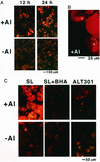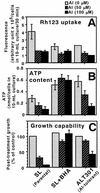Aluminum toxicity is associated with mitochondrial dysfunction and the production of reactive oxygen species in plant cells
- PMID: 11788753
- PMCID: PMC148944
Aluminum toxicity is associated with mitochondrial dysfunction and the production of reactive oxygen species in plant cells
Abstract
Potential mechanisms of Al toxicity measured as Al-induced inhibition of growth in cultured tobacco cells (Nicotiana tabacum, nonchlorophyllic cell line SL) and pea (Pisum sativum) roots were investigated. Compared with the control treatment without Al, the accumulation of Al in tobacco cells caused instantaneously the repression of mitochondrial activities [monitored by the reduction of 3-(4,5-dimethylthiazol-2-yl)-2,5-diphenyl tetrazolium bromide and the uptake of Rhodamine 123] and, after a lag of about 12 h, triggered reactive oxygen species (ROS) production, respiration inhibition, ATP depletion, and the loss of growth capability almost simultaneously. The presence of an antioxidant, butylated hydroxyanisol, during Al treatment of SL cells prevented not only ROS production but also ATP depletion and the loss of growth capability, suggesting that the Al-triggered ROS production seems to be a cause of ATP depletion and the loss of growth capability. Furthermore, these three late events were similarly repressed in an Al-tolerant cell line (ALT301) isolated from SL cells, suggesting that the acquisition of antioxidant functions mimicking butylated hydroxyanisol can be a mechanism of Al tolerance. In the pea root, Al also triggered ROS production, respiration inhibition, and ATP depletion, which were all correlated with inhibition of root elongation. Taken together, we conclude that Al affects mitochondrial functions, which leads to ROS production, probably the key critical event in Al inhibition of cell growth.
Figures







References
-
- Cakmak CJ, Horst WJ. Effect of aluminum on lipid peroxidation, superoxide dismutase, catalase, and peroxidase activities in root tips of soybean (Glycine max) Physiol Plant. 1991;83:463–468.
-
- Costa-Pereira AP, Cotter TG. Metabolic alterations associated with apoptosis. In: Studzinski GP, editor. Apoptosis: A Practical Approach. New York: Oxford University Press; 1999. pp. 141–156.
-
- Darzynkiewicz Z, Bedner E, Li X. Analysis of cell death by flow and laser-scanning cytometry. In: Studzinski GP, editor. Apoptosis: A Practical Approach. New York: Oxford University Press; 1999. pp. 56–80.
-
- Deleers M, Servais JP, Wülfert E. Neurotoxic cations induce membrane rigidification and membrane fusion at micromolar concentrations. Biochim Biophys Acta. 1986;855:271–276. - PubMed
-
- Devi SR, Yamamoto Y, Matsumoto H. Isolation of aluminum tolerant cell lines of tobacco in a simple calcium medium and their responses to aluminum. Physiol Plant. 2001;112:397–402. - PubMed
Publication types
MeSH terms
Substances
LinkOut - more resources
Full Text Sources
Other Literature Sources
